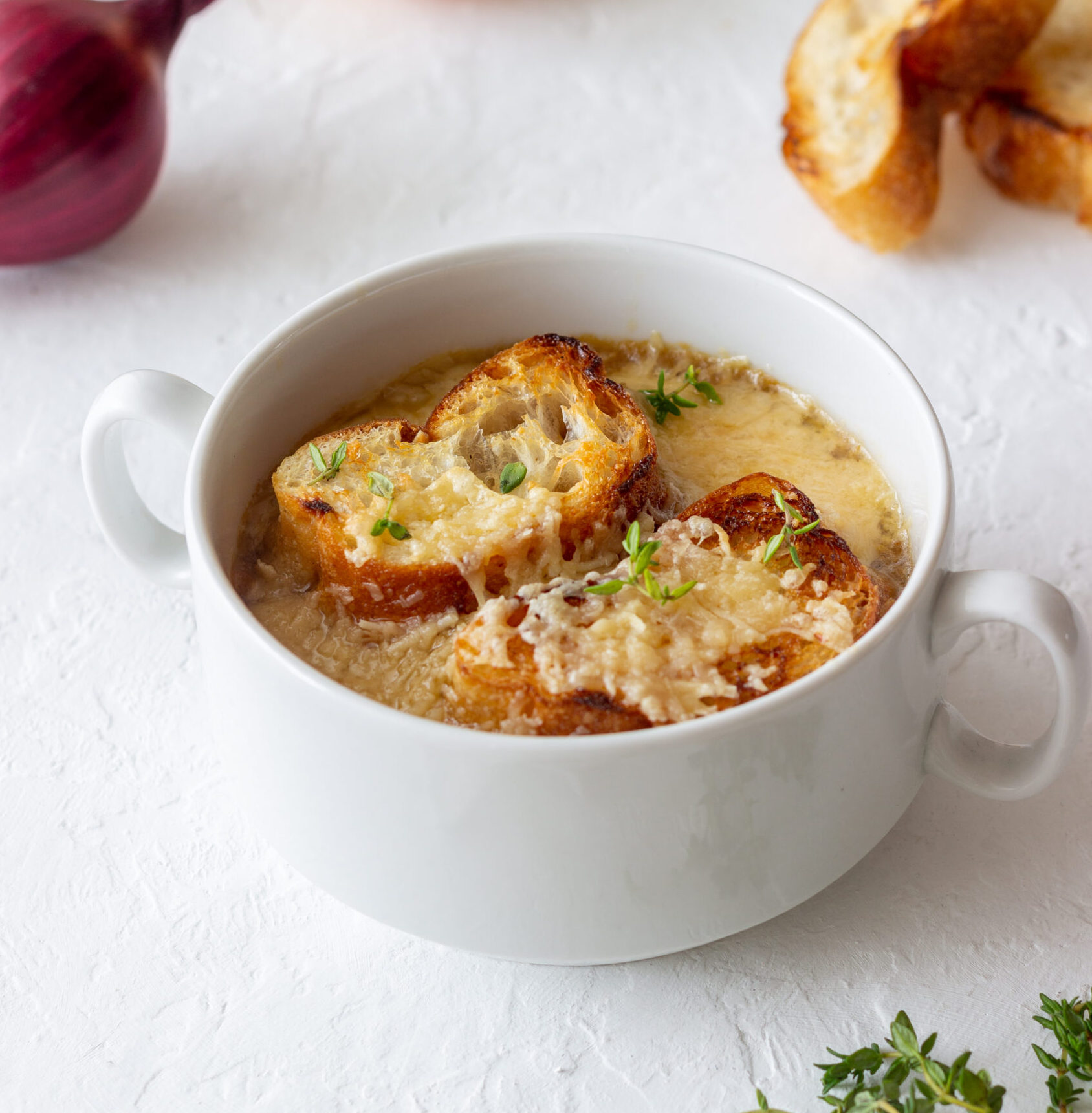French onion soup is a classic dish that embodies the essence of comfort food with its rich, savory flavors and delightful textures. Perfect for cozy dinners or as a sophisticated starter, this dish combines caramelized onions, a robust broth, and a cheesy, toasted topping to create a symphony of taste that warms the soul. Whether you’re a seasoned chef or a home cook eager to explore new culinary horizons, mastering the art of French onion soup can elevate your cooking repertoire. In this guide, we’ll delve into the intricacies of crafting the perfect French onion soup, covering everything from essential equipment to common mistakes and troubleshooting tips.
Essential Equipment for Perfect French Onion Soup
Creating an impeccable French onion soup requires more than just the right ingredients; the equipment you use can significantly impact the outcome. Here are the key tools you’ll need:
- Heavy-bottomed pot: A Dutch oven or a heavy-bottomed saucepan ensures even heat distribution, essential for caramelizing onions without burning them.
- Sharp knife: Precise slicing of onions is crucial, so a well-sharpened chef’s knife is indispensable.
- Oven-safe bowls: Individual oven-safe bowls or crocks are necessary for broiling the cheese-topped soup.
- Wooden spoon: Ideal for stirring onions as they caramelize, preventing them from sticking to the pot.
The hallmark of an exceptional French onion soup lies in its complex flavor profile, which balances sweetness, savoriness, and umami. The caramelized onions contribute a deep sweetness, while the broth adds richness and depth. Topping it off with melted cheese introduces a creamy, slightly salty element that complements the soup’s base flavors.
Choosing the Right Onions: Varieties and Their Impact
Onions are the star of French onion soup, and selecting the right variety can make a significant difference in flavor and texture. Here are the most suitable options:
- Yellow onions: The most common choice, offering a balanced sweetness and savoriness ideal for caramelization.
- White onions: Slightly milder and less sweet, they can be used for a more subtle flavor profile.
- Red onions: While less traditional, they provide a sharper taste and a vibrant color.
- Sweet onions: Varieties like Vidalia or Walla Walla can add an extra layer of sweetness to the soup.
Caramelizing Onions: Techniques for Success
Caramelizing onions is a critical step in developing the soup’s rich flavor. Here’s how to do it right:
- Slice evenly: Uniform slices ensure even cooking. Aim for thin, consistent slices.
- Low and slow: Cook onions over low heat, stirring occasionally. This process can take 30-45 minutes but is crucial for developing flavor.
- Deglaze the pan: Use a splash of water or broth to deglaze the pan if onions start sticking. This also incorporates flavorful bits back into the onions.
- Patience is key: Avoid increasing the heat to speed up the process, as this can lead to burning rather than caramelizing.
Best Broths for French Onion Soup: Beef Broth vs. Beef Stock
The broth forms the backbone of French onion soup, providing the savory depth that balances the sweetness of the onions. While both beef broth and beef stock can be used, they offer different attributes:
- Beef broth: Typically lighter and seasoned, it’s ready to use and provides a straightforward flavor.
- Beef stock: Richer and more gelatinous, it adds body and depth but may require additional seasoning.
For the most flavorful soup, consider using a combination of both, or enhance store-bought versions with herbs and spices.
Incorporating White Wine: Benefits and Tips
White wine is a classic addition to French onion soup, enhancing its complexity. Here’s how to use it effectively:
- Choose dry varieties: Opt for a dry white wine like Sauvignon Blanc or Chardonnay to avoid adding sweetness.
- Deglaze with wine: After caramelizing onions, deglaze the pan with wine to lift flavorful bits and add acidity.
- Cook off the alcohol: Allow the wine to simmer for a few minutes to evaporate the alcohol, leaving behind its nuanced flavors.
Common Mistakes When Making French Onion Soup
Avoid these pitfalls to ensure your French onion soup turns out perfectly every time:
- Rushing the caramelization: Properly caramelized onions are crucial; rushing this step results in less flavor.
- Using the wrong onions: Not all onions are created equal; choosing the right type affects the soup’s sweetness and texture.
- Over-salting: Broths can be salty, so taste as you go and adjust seasoning at the end.
- Skipping the deglaze: Deglazing is essential for incorporating all the flavorful bits from the pot.
Troubleshooting: Fixing Common French Onion Soup Issues
If your soup isn’t turning out as expected, consider these solutions:
- Too sweet: If your soup is overly sweet, balance it with a splash of vinegar or lemon juice.
- Lacking depth: Enhance the broth with a dash of Worcestershire sauce or soy sauce for added umami.
- Thin consistency: Simmer the soup longer to reduce and concentrate flavors, or add a slurry of cornstarch and water for thickening.
Slow Cooker French Onion Soup: A Convenient Alternative
For those seeking convenience, a slow cooker offers an easy way to prepare French onion soup. Here’s how:
- Caramelize onions: Begin by caramelizing onions on the stovetop before transferring them to the slow cooker.
- Add ingredients: Combine onions with broth, wine, and seasonings in the slow cooker.
- Cook low and slow: Set the slow cooker to low and cook for 6-8 hours, allowing flavors to meld.
- Finish with cheese: Before serving, ladle soup into oven-safe bowls, top with bread and cheese, and broil until golden.
Recipe Variations: Unique Twists on Classic French Onion Soup
Experimenting with variations can add exciting new dimensions to your French onion soup. Consider these ideas:
- Vegetarian version: Substitute beef broth with vegetable broth and add mushrooms for umami.
- Cheese alternatives: Try Gruyère, Comté, or Emmental for different flavor profiles.
- Herb-infused: Add herbs like thyme, bay leaves, or rosemary to the broth for aromatic depth.
- Spicy kick: Introduce a pinch of cayenne pepper or a splash of hot sauce for a fiery twist.
What to Pair with Your Soup
French onion soup is versatile and pairs well with various dishes. Here are some suggestions to complete your meal:
- Crusty bread: Serve with a side of crusty baguette or sourdough for dipping.
- Simple salad: A light, crisp salad with vinaigrette complements the soup’s richness.
- Charcuterie board: Offer an assortment of cured meats and cheeses for a sophisticated touch.
- Wine pairing: Pair with a medium-bodied red wine like Pinot Noir or a dry white wine to enhance the flavors.
Storage and Freezing Tips for Leftover Soup
Proper storage ensures your French onion soup remains delicious even after a few days. Here’s how to store it:
- Refrigeration: Allow the soup to cool, then store it in an airtight container in the fridge for up to 3 days.
- Freezing: For longer storage, freeze the soup in portion-sized containers. Leave space for expansion and use within 3 months.
Reheating French Onion Soup
Reheating French onion soup properly preserves its flavors and textures. Follow these steps:
- Stovetop method: Gently reheat the soup in a saucepan over low heat, stirring occasionally until warmed through.
- Microwave option: Use a microwave-safe bowl, cover loosely, and heat in short intervals, stirring in between.
- Broil the topping: For the best experience, re-toast the bread and cheese topping separately under the broiler before serving.
By understanding the nuances of each step and avoiding common pitfalls, you can create a French onion soup that is both authentic and delicious. Whether you stick to the classic recipe or venture into creative variations, this guide equips you with the knowledge to impress your guests and enjoy a hearty, flavorful meal.

